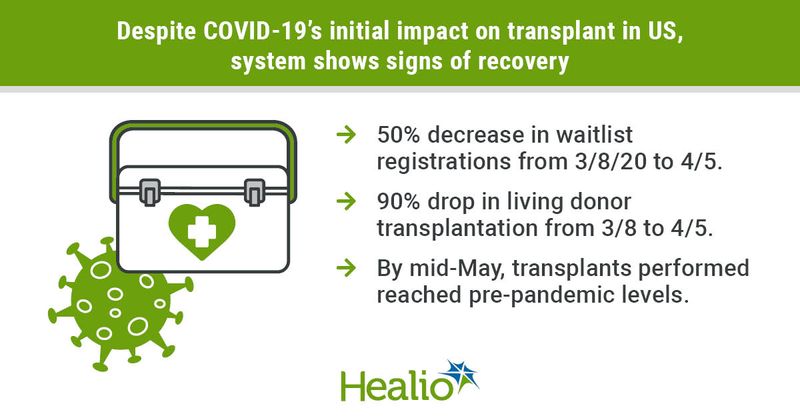COVID-19 causes ‘profound’ drop in transplant rates in US, but system shows ‘resilience’
An analysis of data from the United Network for Organ Sharing suggests the COVID-19 pandemic has had a significant impact on transplantation in the United States, especially in the initial months.
“The impact of the SARS-CoV-2 pandemic on the transplant health care system was abrupt, profound and unprecedented,” Rebecca R. Goff, PhD, of the research department at United Network for Organ Sharing, and colleagues wrote.

“This report describes the initial impacts of the pandemic on the transplant system, including deceased and living donation as well as transplant candidates and recipients, in the U.S. and the responses of the [Organ Procurement and Transplantation Network] OPTN to mitigate adverse outcomes.”
Using data from January 2020 to September 2020, researchers made several key observations. These included the following:
- a decrease in new wait list registrations (50% decrease in the Northeast from the week of March 8 vs. the week of April 5);
- a “near cessation” of living donor transplantation (a 90% drop from the week of March 8 to the week of April 5);
- a 45% drop in deceased donor kidney transplant volume (70% drop for a lung, 43% for heart and 37% for liver); and
- a 45% drop in deceased donors recovered from March 8 vs. April 5.
Of the last point, the researchers noted the largest percent change occurred in the Northeast, which experienced a 67% drop.
Despite this initial impact, Goff and colleagues also found evidence of recovery.
“OPTN data show that by mid-May there was substantial recovery of donor and transplant numbers,” they wrote. “Overall, organ utilization improved and transplants, both deceased and living donor, approached pre-pandemic levels. These observations suggest a resilient transplant system infrastructure that has adapted to a new clinical environment.”
Still, Goff and colleagues contended the effects of the pandemic will need to be handled.
“As the COVID-19 pandemic continues to evolve and COVID-19 cases and COVID-19-related deaths accumulate, it appears that the impact of COVID-19 on the transplant system will not be a transitory event,” they wrote. “There are certain to be long-lasting impacts on the transplant system and health care delivery.”
Further, according to Goff and colleagues, subsequent waves of SARS-CoV-2 infections present a continued challenge and concern to the health care system at large.
“A successful response will require anticipatory policy responses and data collection and the incorporation of accumulated clinical experience into planning and resource allocation,” they concluded. “The continued effective collaboration of the transplant community with its public partners and stakeholders should minimize the impacts of ongoing COVID-19 infections on the transplant system in the U.S.”

